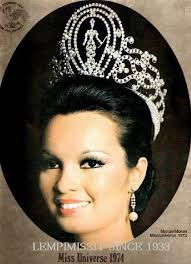CAPIZ BEST FILIPINO BEAUTY QUEEN
Maria Margarita Moran Roxas - Floirendo - Bb. Pilipinas-Universe 1973, Miss Universe 1973 winner.
A granddaughter of former Philippine President Manuel Roxas, she has also been
known as Margie Morán Róxas and later as Margie Morán Róxas De Floirendo or
simply Margie Morán. She was the last Philippine representative to the Miss
Universe Pageant to bring home the crown until Pia Alonzo Wurtzbach 42 years
later in 2015.
Maria
Margarita Roxas Moran-Floirendo is a Filipino peace advocate for her efforts in Mindanao and currently the President of Ballet Philippines. She is best known for winning the second Miss Universe crown for
the Philippines in 1973, 4 years after Gloria
Diaz. She won the right to
represent the country in the Miss
Universe pageant
in Athens, Greece after winning the Binibining Pilipinas competition in 1973. Moran said that she entered the contest because
of the incessant urgings of friends and family. The 19-year-old, 5 ft 6 in
beauty ultimately won the Miss
Universe 1973 title and also garnered the Miss Photogenic award.She is one of the only four Miss Universe
winners to also win Miss Photogenic, the others being Margareta Arvidsson, Janelle Commissiong, and Denise Quiñones.
Two years after her reign, she married and managed to
finish her Business Administration degree at Maryknoll College
and Boston University and took her masters at the
University of London. She
headed several private companies like a resort called "Pearl Farm" in Samal Island, Davao del Norte from 1989 to 1994, hosted
"Margie on Mindanao" on TV and produced a multi-awarded movie, Bagong Buwan. Moran
is also notable for her social and civic works especially for promoting peace
and livelihood as part of the Mindanao Commission on Women Organization and
recently as an ambassador-trustee of Habitat for Humanity
Philippines.

















